Interaction between diet and gastrointestinal endocrine cells (Review)
- Authors:
- Magdy El‑Salhy
- Tarek Mazzawi
- Trygve Hausken
- Jan Gunnar Hatlebakk
-
Affiliations: Section for Gastroenterology, Department of Medicine, Stord Helse‑Fonna Hospital, 5409 Stord, Norway, Section for Gastroenterology, Department of Clinical Medicine, University of Bergen, 5020 Bergen, Norway - Published online on: April 12, 2016 https://doi.org/10.3892/br.2016.649
- Pages: 651-656
-
Copyright: © El‑Salhy et al. This is an open access article distributed under the terms of Creative Commons Attribution License.
This article is mentioned in:
Abstract
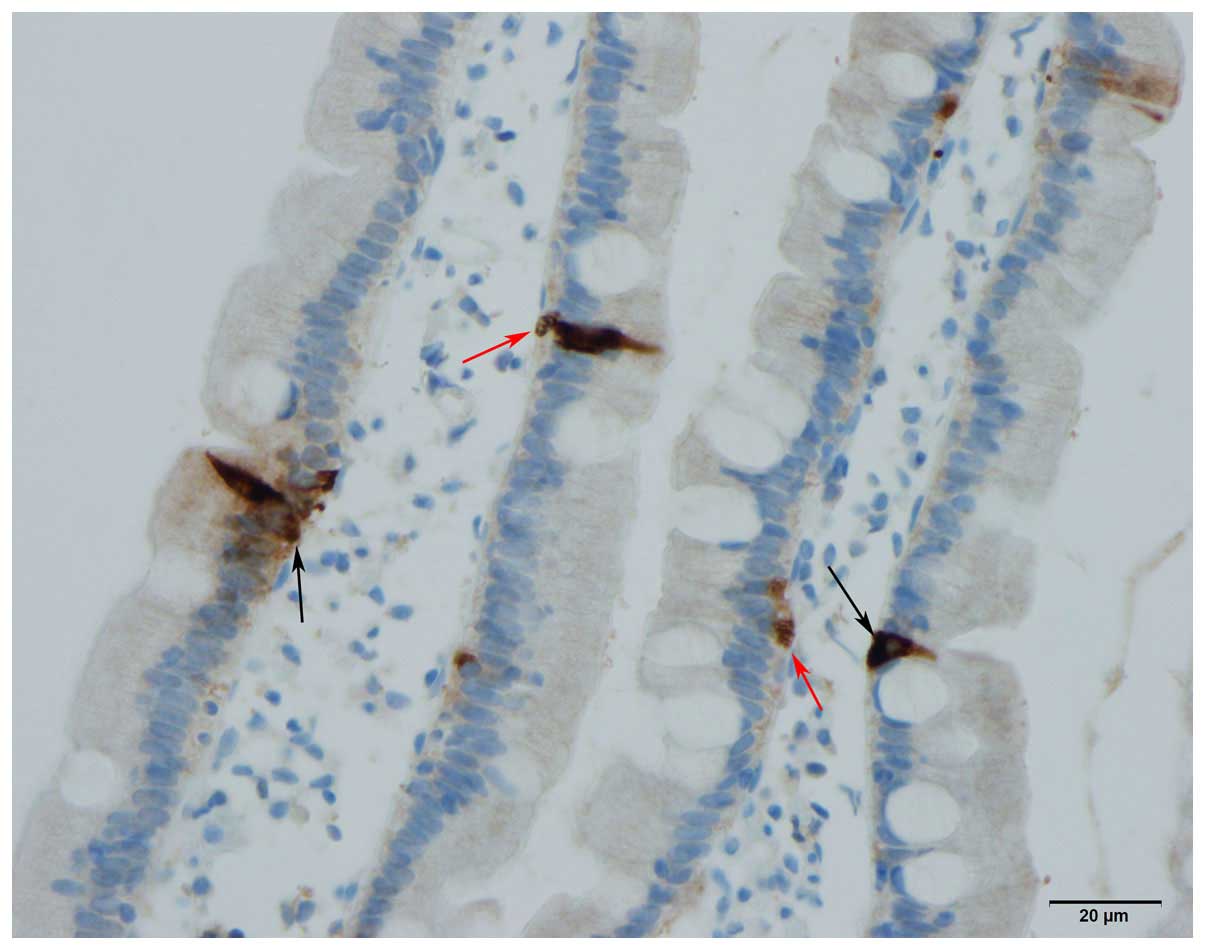 |
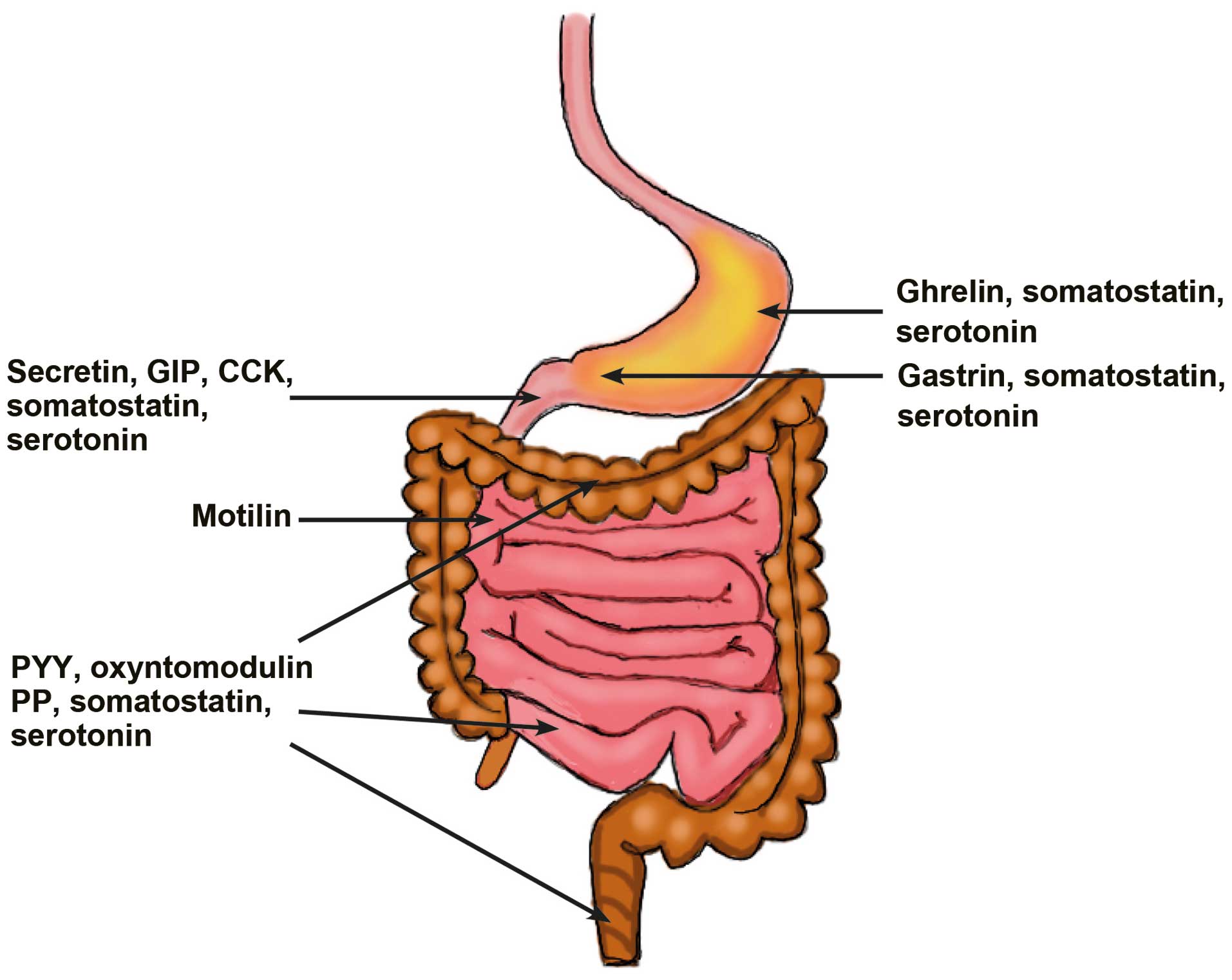 |
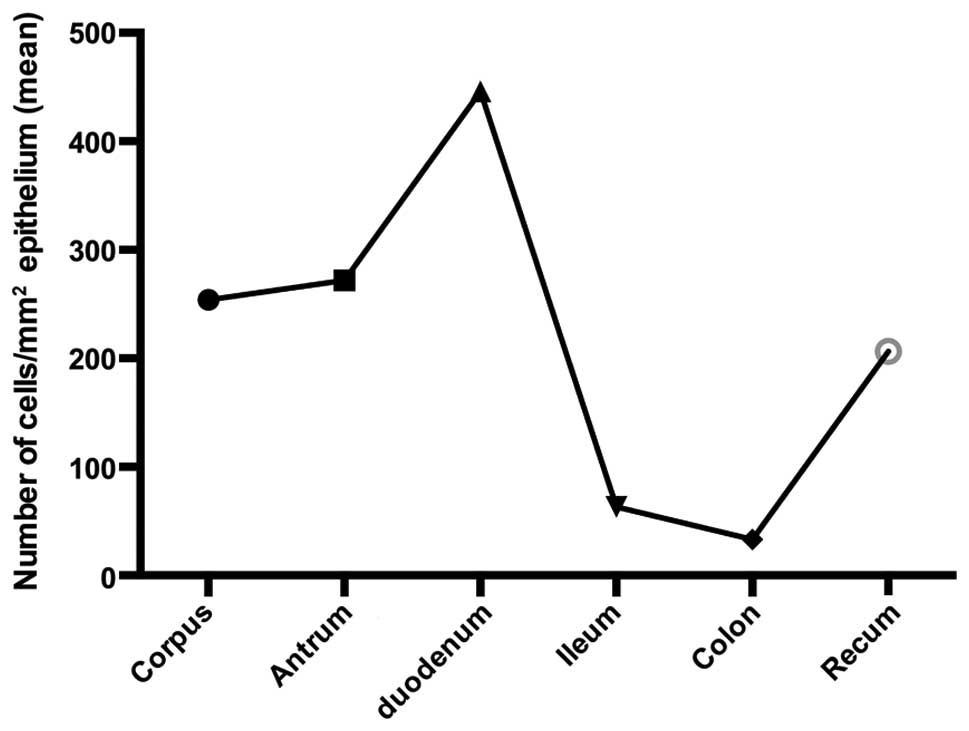 |
 |
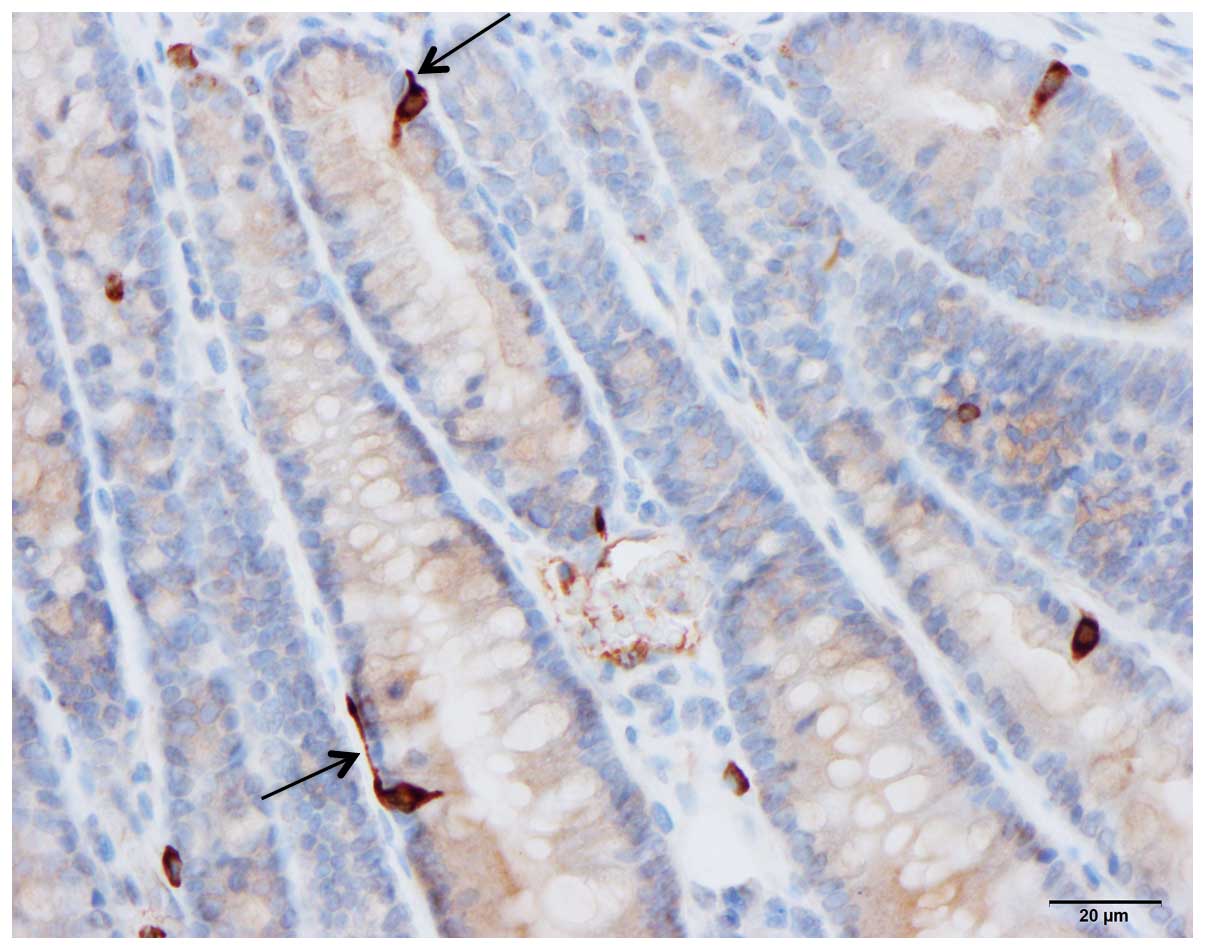 |
 |
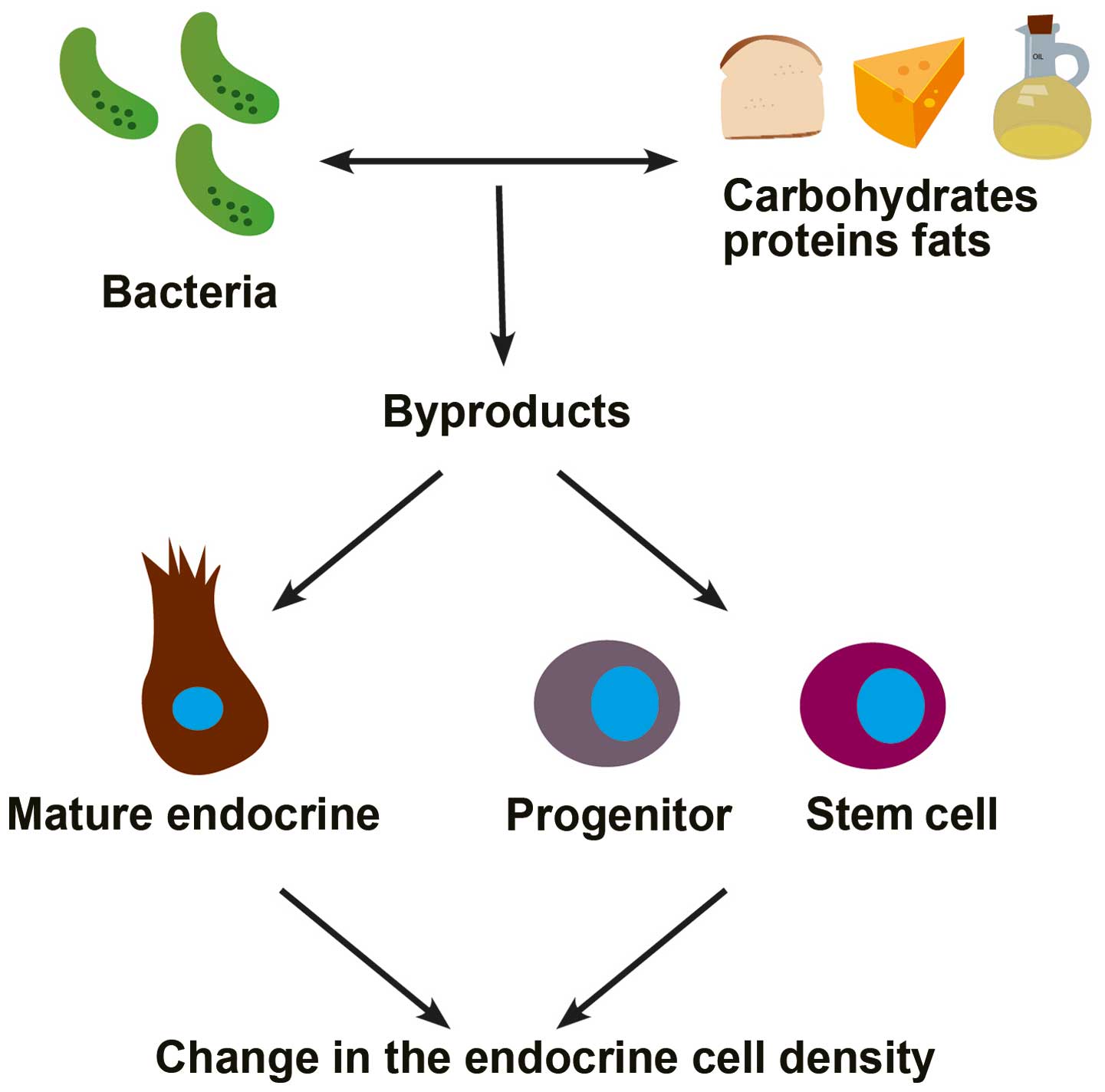 |
|
El-Salhy M, Gilja OH, Gundersen D, Hatlebakk JG and Hausken T: Interaction between ingested nutrients and gut endocrine cells in patients with irritable bowel syndrome (Review). Int J Mol Med. 34:363–371. 2014.PubMed/NCBI | |
|
Mittermaier C, Dejaco C, Waldhoer T, Oefferlbauer-Ernst A, Miehsler W, Beier M, Tillinger W, Gangl A and Moser G: Impact of depressive mood on relapse in patients with inflammatory bowel disease: A prospective 18-month follow-up study. Psychosom Med. 66:79–84. 2004. View Article : Google Scholar : PubMed/NCBI | |
|
Mazzawi T, Gundersen D, Hausken T and El-Salhy M: Increased gastric chromogranin A cell density following changes to diets of patients with irritable bowel syndrome. Mol Med Rep. 10:2322–2326. 2014.PubMed/NCBI | |
|
Mazzawi T, Gundersen D, Hausken T and El-Salhy M: Increased chromogranin A cell density in the large intestine of patients with irritable bowel syndrome after receiving dietary guidance. Gastroenterol Res Pract. 2015:8238972015. View Article : Google Scholar : PubMed/NCBI | |
|
Mazzawi T, Hausken T, Gundersen D and El-Salhy M: Effect of dietary management on the gastric endocrine cells in patients with irritable bowel syndrome. Eur J Clin Nutr. 69:519–524. 2014. View Article : Google Scholar : PubMed/NCBI | |
|
Mazzawi T, Hausken T, Gundersen D and El-Salhy M: Normalization of large intestinal endocrine cells following dietary management in patients with irritable bowel syndrome. Eur J Clin Nutr. 70:175–178. 2016. View Article : Google Scholar : PubMed/NCBI | |
|
El-Salhy M, Seim I, Chopin L, Gundersen D, Hatlebakk JG and Hausken T: Irritable bowel syndrome: The role of gut neuroendocrine peptides. Front Biosci (Elite Ed). 4:2783–2800. 2012. View Article : Google Scholar : PubMed/NCBI | |
|
El-Salhy M, Gundersen D, Hatlebakk JG and Hausken T: Irritable bowel syndrome: diagnosis, pathogenesis and treatment options. Nova Science Publishers, Inc. New York, NY: 2012. | |
|
May CL and Kaestner KH: Gut endocrine cell development. Mol Cell Endocrinol. 323:70–75. 2010. View Article : Google Scholar : PubMed/NCBI | |
|
Gunawardene AR, Corfe BM and Staton CA: Classification and functions of enteroendocrine cells of the lower gastrointestinal tract. Int J Exp Pathol. 92:219–231. 2011. View Article : Google Scholar : PubMed/NCBI | |
|
El-Salhy M, Grimelius L, Wilander E, Ryberg B, Terenius L, Lundberg JM and Tatemoto K: Immunocytochemical identification of polypeptide YY (PYY) cells in the human gastrointestinal tract. Histochemistry. 77:15–23. 1983. View Article : Google Scholar : PubMed/NCBI | |
|
El-Salhy M, Gilja OH, Gundersen D, Hatlebakk JG and Hausken T: Duodenal chromogranin a cell density as a biomarker for the diagnosis of irritable bowel syndrome. Gastroenterol Res Pract. 2014:4628562014. View Article : Google Scholar : PubMed/NCBI | |
|
El-Salhy M, Gilja OH and Hausken T: Chromogranin A cells in the stomachs of patients with sporadic irritable bowel syndrome. Mol Med Rep. 10:1753–1757. 2014.PubMed/NCBI | |
|
El-Salhy M, Mazzawi T, Gundersen D and Hausken T: Chromogranin A cell density in the rectum of patients with irritable bowel syndrome. Mol Med Rep. 6:1223–1225. 2012.PubMed/NCBI | |
|
El-Salhy M, Lomholt-Beck B and Hausken T: Chromogranin A as a possible tool in the diagnosis of irritable bowel syndrome. Scand J Gastroenterol. 45:1435–1439. 2010. View Article : Google Scholar : PubMed/NCBI | |
|
El-Salhy M, Wendelbo IH and Gundersen D: Reduced chromogranin A cell density in the ileum of patients with irritable bowel syndrome. Mol Med Rep. 7:1241–1244. 2013.PubMed/NCBI | |
|
El-Salhy M, Ostgaard H, Gundersen D, Hatlebakk JG and Hausken T: The role of diet in the pathogenesis and management of irritable bowel syndrome (Review). Int J Mol Med. 29:723–731. 2012.PubMed/NCBI | |
|
El-Salhy M: Irritable bowel syndrome: Diagnosis and pathogenesis. World J Gastroenterol. 18:5151–5163. 2012.PubMed/NCBI | |
|
Mawe GM, Coates MD and Moses PL: Review article: Intestinal serotonin signalling in irritable bowel syndrome. Aliment Pharmacol Ther. 23:1067–1076. 2006. View Article : Google Scholar : PubMed/NCBI | |
|
Wade PR, Chen J, Jaffe B, Kassem IS, Blakely RD and Gershon MD: Localization and function of a 5-HT transporter in crypt epithelia of the gastrointestinal tract. J Neurosci. 16:2352–2364. 1996.PubMed/NCBI | |
|
Gershon MD and Tack J: The serotonin signaling system: From basic understanding to drug development for functional GI disorders. Gastroenterology. 132:397–414. 2007. View Article : Google Scholar : PubMed/NCBI | |
|
Gershon MD: 5-Hydroxytryptamine (serotonin) in the gastrointestinal tract. Curr Opin Endocrinol Diabetes Obes. 20:14–21. 2013. View Article : Google Scholar : PubMed/NCBI | |
|
Gershon MD: Serotonin is a sword and a shield of the bowel: Serotonin plays offense and defense. Trans Am Clin Climatol Assoc. 123:268–280; discussion 280. 2012.PubMed/NCBI | |
|
El-Salhy M, Mazzawi T, Gundersen D, Hatlebakk JG and Hausken T: The role of peptide YY in gastrointestinal diseases and disorders (Review). Int J Mol Med. 31:275–282. 2013.PubMed/NCBI | |
|
Dubrasquet M, Bataille D and Gespach C: Oxyntomodulin (glucagon-37 or bioactive enteroglucagon): A potent inhibitor of pentagastrin-stimulated acid secretion in rats. Biosci Rep. 2:391–395. 1982. View Article : Google Scholar : PubMed/NCBI | |
|
Schjoldager BT, Baldissera FG, Mortensen PE, Holst JJ and Christiansen J: Oxyntomodulin: A potential hormone from the distal gut. Pharmacokinetics and effects on gastric acid and insulin secretion in man. Eur J Clin Invest. 18:499–503. 1988. View Article : Google Scholar : PubMed/NCBI | |
|
Schjoldager B, Mortensen PE, Myhre J, Christiansen J and Holst JJ: Oxyntomodulin from distal gut. Role in regulation of gastric and pancreatic functions. Dig Dis Sci. 34:1411–1419. 1989. View Article : Google Scholar : PubMed/NCBI | |
|
Dakin CL, Small CJ, Batterham RL, Neary NM, Cohen MA, Patterson M, Ghatei MA and Bloom SR: Peripheral oxyntomodulin reduces food intake and body weight gain in rats. Endocrinology. 145:2687–2695. 2004. View Article : Google Scholar : PubMed/NCBI | |
|
Wynne K, Park AJ, Small CJ, Patterson M, Ellis SM, Murphy KG, Wren AM, Frost GS, Meeran K, Ghatei MA, et al: Subcutaneous oxyntomodulin reduces body weight in overweight and obese subjects: A double-blind, randomized, controlled trial. Diabetes. 54:2390–2395. 2005. View Article : Google Scholar : PubMed/NCBI | |
|
Camilleri M: Peripheral mechanisms in irritable bowel syndrome. N Engl J Med. 367:1626–1635. 2012. View Article : Google Scholar : PubMed/NCBI | |
|
Jianu CS, Fossmark R, Syversen U, Hauso Ø and Waldum HL: A meal test improves the specificity of chromogranin A as a marker of neuroendocrine neoplasia. Tumour Biol. 31:373–380. 2010. View Article : Google Scholar : PubMed/NCBI | |
|
Seim I, El-Salhy M, Hausken T, Gundersen D and Chopin L: Ghrelin and the brain-gut axis as a pharmacological target for appetite control. Curr Pharm Des. 18:768–775. 2012. View Article : Google Scholar : PubMed/NCBI | |
|
Wang J, Cortina G, Wu SV, Tran R, Cho JH, Tsai MJ, Bailey TJ, Jamrich M, Ament ME, Treem WR, et al: Mutant neurogenin-3 in congenital malabsorptive diarrhea. N Engl J Med. 355:270–280. 2006. View Article : Google Scholar : PubMed/NCBI | |
|
Ghia JE, Blennerhassett P, Deng Y, Verdu EF, Khan WI and Collins SM: Reactivation of inflammatory bowel disease in a mouse model of depression. Gastroenterology. 136:2280–2288, e1–4. 2009. View Article : Google Scholar : PubMed/NCBI | |
|
Spångéus A, Forsgren S and el-Salhy M: Does diabetic state affect co-localization of peptide YY and enteroglucagon in colonic endocrine cells? Histol Histopathol. 15:37–41. 2000.PubMed/NCBI | |
|
Pyarokhil AH, Ishihara M, Sasaki M and Kitamura N: The developmental plasticity of colocalization pattern of peptide YY and glucagon-like peptide-1 in the endocrine cells of bovine rectum. Biomed Res. 33:35–38. 2012. View Article : Google Scholar : PubMed/NCBI | |
|
Haroon E, Raison CL and Miller AH: Psychoneuroimmunology meets neuropsychopharmacology: Translational implications of the impact of inflammation on behavior. Neuropsychopharmacology. 37:137–162. 2012. View Article : Google Scholar : PubMed/NCBI | |
|
El-Salhy M, Wilander E and Grimelius L: Immunocytochemical localization of gastric inhibitory peptide (GIP) in the human foetal pancreas. Ups J Med Sci. 87:81–85. 1982. View Article : Google Scholar : PubMed/NCBI | |
|
Ghia JE, Li N, Wang H, Collins M, Deng Y, El-Sharkawy RT, Côté F, Mallet J and Khan WI: Serotonin has a key role in pathogenesis of experimental colitis. Gastroenterology. 137:1649–1660. 2009. View Article : Google Scholar : PubMed/NCBI | |
|
Dryden S, Wang Q, Frankish HM, Pickavance L and Williams G: The serotonin (5-HT) antagonist methysergide increases neuropeptide Y (NPY) synthesis and secretion in the hypothalamus of the rat. Brain Res. 699:12–18. 1995. View Article : Google Scholar : PubMed/NCBI | |
|
Sandström O and El-Salhy M: Ageing and endocrine cells of human duodenum. Mech Ageing Dev. 108:39–48. 1999. View Article : Google Scholar : PubMed/NCBI | |
|
El-Salhy M: Ghrelin in gastrointestinal diseases and disorders: A possible role in the pathophysiology and clinical implications (Review). Int J Mol Med. 24:727–732. 2009. View Article : Google Scholar : PubMed/NCBI | |
|
Tolhurst G, Reimann F and Gribble FM: Intestinal sensing of nutrients. Handb Exp Pharmacol. 209:309–335. 2012. View Article : Google Scholar : PubMed/NCBI | |
|
Lee J, Cummings BP, Martin E, Sharp JW, Graham JL, Stanhope KL, Havel PJ and Raybould HE: Glucose sensing by gut endocrine cells and activation of the vagal afferent pathway is impaired in a rodent model of type 2 diabetes mellitus. Am J Physiol Regul Integr Comp Physiol. 302:R657–R666. 2012. View Article : Google Scholar : PubMed/NCBI | |
|
Parker HE, Reimann F and Gribble FM: Molecular mechanisms underlying nutrient-stimulated incretin secretion. Expert Rev Mol Med. 12:e12010. View Article : Google Scholar : PubMed/NCBI | |
|
Raybould HE: Nutrient sensing in the gastrointestinal tract: Possible role for nutrient transporters. J Physiol Biochem. 64:349–356. 2008. View Article : Google Scholar : PubMed/NCBI | |
|
San Gabriel A, Nakamura E, Uneyama H and Torii K: Taste, visceral information and exocrine reflexes with glutamate through umami receptors. J Med Invest. 56:209–217. 2009. View Article : Google Scholar : PubMed/NCBI | |
|
Rudholm T, Wallin B, Theodorsson E, Näslund E and Hellström PM: Release of regulatory gut peptides somatostatin, neurotensin and vasoactive intestinal peptide by acid and hyperosmolal solutions in the intestine in conscious rats. Regul Pept. 152:8–12. 2009. View Article : Google Scholar : PubMed/NCBI | |
|
Sternini C, Anselmi L and Rozengurt E: Enteroendocrine cells: A site of ‘taste’ in gastrointestinal chemosensing. Curr Opin Endocrinol Diabetes Obes. 15:73–78. 2008. View Article : Google Scholar : PubMed/NCBI | |
|
Sternini C: Taste receptors in the gastrointestinal tract. IV. Functional implications of bitter taste receptors in gastrointestinal chemosensing. Am J Physiol Gastrointest Liver Physiol. 292:G457–G461. 2007. View Article : Google Scholar : PubMed/NCBI | |
|
Buchan AM: Nutrient Tasting and signaling mechanisms in the gut III. Endocrine cell recognition of luminal nutrients. Am J Physiol. 277:G1103–G1107. 1999.PubMed/NCBI | |
|
Montero-Hadjadje M, Elias S, Chevalier L, Benard M, Tanguy Y, Turquier V, Galas L, Yon L, Malagon MM, Driouich A, et al: Chromogranin A promotes peptide hormone sorting to mobile granules in constitutively and regulated secreting cells: Role of conserved N- and C-terminal peptides. J Biol Chem. 284:12420–12431. 2009. View Article : Google Scholar : PubMed/NCBI | |
|
Shooshtarizadeh P, Zhang D, Chich JF, Gasnier C, Schneider F, Haïkel Y, Aunis D and Metz-Boutigue MH: The antimicrobial peptides derived from chromogranin/secretogranin family, new actors of innate immunity. Regul Pept. 165:102–110. 2010. View Article : Google Scholar : PubMed/NCBI | |
|
Reber SO, Obermeier F, Straub RH, Falk W and Neumann ID: Chronic intermittent psychosocial stress (social defeat/overcrowding) in mice increases the severity of an acute DSS-induced colitis and impairs regeneration. Endocrinology. 147:4968–4976. 2006. View Article : Google Scholar : PubMed/NCBI | |
|
Milde AM and Murison R: A study of the effects of restraint stress on colitis induced by dextran sulphate sodium in singly housed rats. Integr Physiol Behav Sci. 37:140–150. 2002. View Article : Google Scholar : PubMed/NCBI | |
|
Furness JB, Kunze WA and Clerc N: Nutrient tasting and signaling mechanisms in the gut. II. The intestine as a sensory organ: Neural, endocrine, and immune responses. Am J Physiol. 277:G922–G928. 1999.PubMed/NCBI | |
|
Hassani H, Lucas G, Rozell B and Ernfors P: Attenuation of acute experimental colitis by preventing NPY Y1 receptor signaling. Am J Physiol Gastrointest Liver Physiol. 288:G550–G556. 2005. View Article : Google Scholar : PubMed/NCBI | |
|
Cani PD, Everard A and Duparc T: Gut microbiota, enteroendocrine functions and metabolism. Curr Opin Pharmacol. 13:935–940. 2013. View Article : Google Scholar : PubMed/NCBI | |
|
Cani PD, Hoste S, Guiot Y and Delzenne NM: Dietary non-digestible carbohydrates promote L-cell differentiation in the proximal colon of rats. Br J Nutr. 98:32–37. 2007. View Article : Google Scholar : PubMed/NCBI | |
|
Petitto JM, Huang Z and McCarthy DB: Molecular cloning of NPY-Y1 receptor cDNA from rat splenic lymphocytes: Evidence of low levels of mRNA expression and [125I]NPY binding sites. J Neuroimmunol. 54:81–86. 1994. View Article : Google Scholar : PubMed/NCBI | |
|
De la Fuente M, Bernaez I, Del Rio M and Hernanz A: Stimulation of murine peritoneal macrophage functions by neuropeptide Y and peptide YY. Involvement of protein kinase C. Immunology. 80:259–265. 1993.PubMed/NCBI | |
|
Shibata M, Hisajima T, Nakano M, Goris RC and Funakoshi K: Morphological relationships between peptidergic nerve fibers and immunoglobulin A-producing lymphocytes in the mouse intestine. Brain Behav Immun. 22:158–166. 2008. View Article : Google Scholar : PubMed/NCBI | |
|
Painsipp E, Herzog H, Sperk G and Holzer P: Sex-dependent control of murine emotional-affective behaviour in health and colitis by peptide YY and neuropeptide Y. Br J Pharmacol. 163:1302–1314. 2011. View Article : Google Scholar : PubMed/NCBI | |
|
Rindi G, Inzani F and Solcia E: Pathology of gastrointestinal disorders. Endocrinol Metab Clin North Am. 39:713–727. 2010. View Article : Google Scholar : PubMed/NCBI | |
|
Cummings DE and Overduin J: Gastrointestinal regulation of food intake. J Clin Invest. 117:13–23. 2007. View Article : Google Scholar : PubMed/NCBI | |
|
Bertrand PP: The cornucopia of intestinal chemosensory transduction. Front Neurosci. 3:482009.PubMed/NCBI | |
|
Bertrand PP and Bertrand RL: Serotonin release and uptake in the gastrointestinal tract. Auton Neurosci. 153:47–57. 2010. View Article : Google Scholar : PubMed/NCBI | |
|
El-Salhy M, Grimelius L, Wilander E, Abu-Sinna G and Lundqvist G: Histological and immunohistochemical studies of the endocrine cells of the gastrointestinal mucosa of the toad (Bufo regularis). Histochemistry. 71:53–65. 1981. View Article : Google Scholar : PubMed/NCBI | |
|
Sandstrom O: Age-related changes in the neuroendocrine system of the gut. Umea Univ Med Diss. 617:1–46. 1999. | |
|
Bohórquez DV, Chandra R, Samsa LA, Vigna SR and Liddle RA: Characterization of basal pseudopod-like processes in ileal and colonic PYY cells. J Mol Histol. 42:3–13. 2011. View Article : Google Scholar : PubMed/NCBI | |
|
Gustafsson BI, Bakke I, Hauso Ø, Kidd M, Modlin IM, Fossmark R, Brenna E and Waldum HL: Parietal cell activation by arborization of ECL cell cytoplasmic projections is likely the mechanism for histamine induced secretion of hydrochloric acid. Scand J Gastroenterol. 46:531–537. 2011. View Article : Google Scholar : PubMed/NCBI | |
|
Gustafsson BI, Bakke I, Tømmerås K and Waldum HL: A new method for visualization of gut mucosal cells, describing the enterochromaffin cell in the rat gastrointestinal tract. Scand J Gastroenterol. 41:390–395. 2006. View Article : Google Scholar : PubMed/NCBI | |
|
Pang XH, Li TK, Xie Q, He FQ, Cui J, Chen YQ, Huang XL and Gan HT: Amelioration of dextran sulfate sodium-induced colitis by neuropeptide Y antisense oligodeoxynucleotide. Int J Colorectal Dis. 25:1047–1053. 2010. View Article : Google Scholar : PubMed/NCBI | |
|
Bohórquez DV, Samsa LA, Roholt A, Medicetty S, Chandra R and Liddle RA: An enteroendocrine cell-enteric glia connection revealed by 3D electron microscopy. PLoS One. 9:e898812014. View Article : Google Scholar : PubMed/NCBI | |
|
Bohórquez DV, Shahid RA, Erdmann A, Kreger AM, Wang Y, Calakos N, Wang F and Liddle RA: Neuroepithelial circuit formed by innervation of sensory enteroendocrine cells. J Clin Invest. 125:782–786. 2015. View Article : Google Scholar : PubMed/NCBI | |
|
El-Salhy M: On the phylogeny of the gastro-entero-pancreatic (GEP) neuroendocrine system. Acta Uni Uppsal. 385:1–39. 1981. | |
|
El-Salhy M, Abou-el-Ela R, Falkmer S, Grimelius L and Wilander E: Immunohistochemical evidence of gastro-entero-pancreatic neurohormonal peptides of vertebrate type in the nervous system of the larva of a dipteran insect, the hoverfly, Eristalis aeneus. Regul Pept. 1:187–204. 1980. View Article : Google Scholar : PubMed/NCBI | |
|
El-Salhy M, Falkmer S, Kramer KJ and Speirs RD: Immunohistochemical investigations of neuropeptides in the brain, corpora cardiaca, and corpora allata of an adult lepidopteran insect, Manduca sexta (L). Cell Tissue Res. 232:295–317. 1983. View Article : Google Scholar : PubMed/NCBI | |
|
El-Salhy M, Falkmer S, Kramer KJ and Speirs RD: Immunocytochemical evidence for the occurrence of insulin in the frontal ganglion of a Lepidopteran insect, the tobacco hornworm moth, Manduca sexta L. Gen Comp Endocrinol. 54:85–88. 1984. View Article : Google Scholar : PubMed/NCBI | |
|
Mazzawi T, Hausken T, Gundersen D and El-Salhy M: Effects of dietary guidance on the symptoms, quality of life and habitual dietary intake of patients with irritable bowel syndrome. Mol Med Rep. 8:845–852. 2013.PubMed/NCBI | |
|
Ostgaard H, Hausken T, Gundersen D and El-Salhy M: Diet and effects of diet management on quality of life and symptoms in patients with irritable bowel syndrome. Mol Med Rep. 5:1382–1390. 2012.PubMed/NCBI | |
|
García-Martínez JM, Chocarro-Calvo A, De la Vieja A and García-Jiménez C: Insulin drives glucose-dependent insulinotropic peptide expression via glucose-dependent regulation of FoxO1 and LEF1/β-catenin. Biochim Biophys Acta. 1839:1141–1150. 2014. View Article : Google Scholar : PubMed/NCBI | |
|
García-Martínez JM, Chocarro-Calvo A, Moya CM and García-Jiménez C: WNT/beta-catenin increases the production of incretins by entero-endocrine cells. Diabetologia. 52:1913–1924. 2009. View Article : Google Scholar : PubMed/NCBI | |
|
Freeland KR, Wilson C and Wolever TM: Adaptation of colonic fermentation and glucagon-like peptide-1 secretion with increased wheat fibre intake for 1 year in hyperinsulinaemic human subjects. Br J Nutr. 103:82–90. 2010. View Article : Google Scholar : PubMed/NCBI | |
|
Korner J, Bessler M, Inabnet W, Taveras C and Holst JJ: Exaggerated glucagon-like peptide-1 and blunted glucose-dependent insulinotropic peptide secretion are associated with Roux-en-Y gastric bypass but not adjustable gastric banding. Surg Obes Relat Dis. 3:597–601. 2007. View Article : Google Scholar : PubMed/NCBI |









